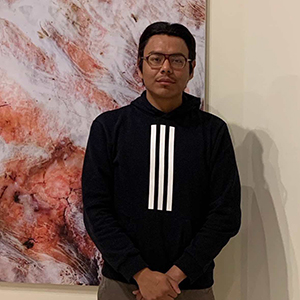

Diné artist Rapheal Begay at the opening of A Vernacular Response Photography of the Navajo Nation by Rapheal Begay
Michelle H asks: How do you come up with new ideas or themes for temporary exhibits?
Like most things that happen in the complex environment of a museum, there is no one path for coming up with themes for temporary exhibitions. They may come from inside the museum, from curators and other staff who have ideas based on their research and experience in collections. Or they may come from outside the museum, from scholars or individuals who have been researching in our collections or who have a stake in the collections we hold and topics we cover as an anthropology museum.
This does mean that because a large part of our collection comes from communities of the American Southwest — specifically Indigenous and Nuevo Mexicano communities — our exhibitions often have these communities centrally embedded in their theme. However, that is not always the case. Typically, the process begins with an informal conversation between the person proposing the idea to our Curator of Exhibitions/Head of Interpretation Devorah Romanek. This is followed by a more formal process of review, as we decide if the proposed exhibit is a good fit for our museum and also consider more practical concerns of schedule, cost, and feasibility. Once a topic for an exhibition is selected, many months of work follow involving staff in our Interpretation Division and across the museum to turn the concept into a physical or, increasingly, virtual exhibition.
Another large factor contributing to decisions we make about which exhibitions we will produce and the themes they embody, has to do with the vision we have at our museum, embodied in our commitment to reconciling injustices, restoring voices, and realizing community. This means that we very seriously consider contemporary issues of social justice when making decisions about exhibitions, even if the theme has a historical base or background. This is particularly reflected in our series: Current Issues in Anthropology, which has featured exhibitions on gun violence, the threats of climate change, Indigenous resistance to the Dakota Access Pipeline, and the New Mexico-Mexico borderlands and migration policies, among other current topics.
By Curator of Exhibitions, Devorah Romanek